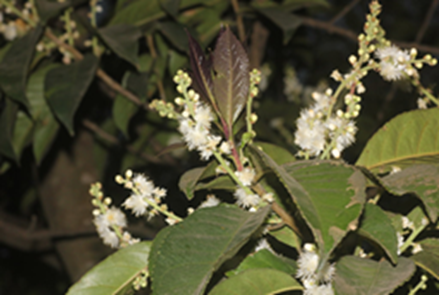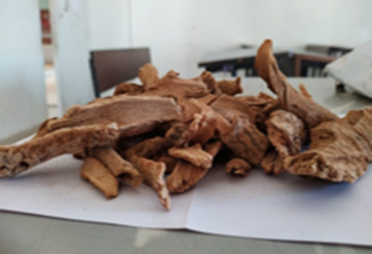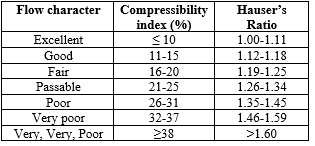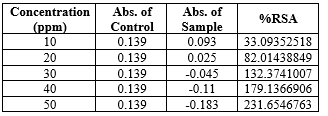Abstract
Granulation, or the agglomeration process that enlarges patches, is one of the most important unit processes in the manufacturing of pharmaceutical lozenge forms, which are substantially tablets and capsules. The purpose of this study was to develop and estimate a nutraceutical formulation.The granules were made using the wet granulation system, with the active medicinal element being an ethanolic excerpt of Lodhra( Symplocos racemosa) combined with sodium glycolate and cross carmellose sodium as disintegrants. The grains were estimated grounded on a number of aspects, similar as appearance, inflow characteristics, angle of repose, bulk viscosity, antioxidant exertion, and disintegrating exertion.
Keywords
Neutraceuticals , wet granulation, Lodhra, granules, disintegrants
Introduction
The words" nutrition" and" pharmaceutics" combine to form the term" nutraceuticals." The expression refers to particulars that are separated from herbal goods, salutary supplements( nutrients), certain diets, and reused refections like cereals, mists, and drinks that serve as specifics in addition to being nutritive supplements.[1]Nutraceuticals are goods that are used as specifics in addition to being used for nutrition. These are pharmaceutical phrasings with food bioactive factors as the active constituents( capsules, maquillages, capsules, vials, etc.). These days, there's a lot of interest in nutraceuticals because of their possible benefits in terms of nutrition, safety, and remedy.[2]Plant-based foods, including wine, fruits, nuts, vegetables, grains, legumes, spices, and so on, are widely acknowledged to have some positive health impacts, especially when it comes to age-related illnesses.[3] Among these dietary supplements that are utilised for reasons other than nutrition are nutraceuticals.[4] Oral Drug Delivery System: Due to benefits including patient choice, cost-effectiveness, ease of large-scale manufacturing of oral dosage forms, and convenience of administering herbs orally, oral medication is the most popular method of herbal administration.[5,6]
ANTIOXIDANTS:
Antioxidants are man- made or natural substances that may help or delay some types of cell damage. Antioxidants are set up in numerous foods, including fruits and vegetables. shops and creatures maintain complex systems of multiple types of antioxidants, similar as glutathione, vitamin C, vitamin A, and vitamin E as well as enzymes similar as catalase, superoxide dismutase and colorful peroxides. Antioxidants are the substance that inhibits oxidation or responses promoted by oxygen peroxides or free revolutionaries. These antioxidants give protection against damage caused by free revolutionaries played important places in the development of numerous habitual complaint including cardiovascular conditions, growing, heart complaint, anemia, cancer, inflammation. Antioxidants are substances which slacken or help the deterioration, damage, or destruction caused by oxidation. Free revolutionaries are a major cause of numerous degenerative conditions. They're the major part of the most generally known nutrients. [10,11,12,13,14] Higher consumption of antioxidant-rich fruits, vegetables, and legumes is linked to a lower incidence of chronic oxidative stress-related diseases, such as cancer, cardiovascular disease, and deaths from all causes, according to epidemiological prospective research. It is thought that a plant-based diet guards against illnesses linked to persistent oxidative stress.[15]
Types of antioxidants [16]
- Salutary antioxidants: The salutary antioxidants similar as ascorbates, tocopherols and carotenoids are well known.
- Synthetic antioxidant: Synthetic antioxidants are chemically synthesized since they don't do in nature and are added to food as preservatives to help lipid oxidation.
- Natural antioxidant :natural antioxidants are ingredients of numerous fruits and vegetables. d) Endogenous antioxidants In addition to salutary antioxidants, the body relies on several endogenous defense mechanisms to help cover against free revolutionary convinced cell damage.
- The most popular techniques for assessing a compound's antioxidant activity are DPPH and ABTS+ scavenging assays because of their straightforward, quick, accurate, and repeatable processes. [17]
HERB PROFILE:
Under the scientific name Symplocos racemosa roxb, lodhra is a long-used medicinal herb in Ayurvedic medicine and a vital member of the Symplocaceae family. the most significant part is the stem bark. The Lodhra tree is a tropical evergreen. [18]’

Figure 1. Symplococos racemose plant

Figure 2. Symplococos racemosa dried bark
Lodhra's phytochemical components[19]: This amazing herb demonstrates the presence of bio-active components such as betulinic acid, symposide, salireposide, acetyl symplocososide, ellagic acid, flavonoids, benzoylsalireposide, salireposide, symplocososide, betasito-glycoside, salireposide, and so forth. Astringent, anti-ulcer, digestive, expectorant, hypolipidemic, anti-inflammatory, anti-androgenic, anti-diabetic, anti-cancer, and anti-fibrinolytic properties are just a few of the benefits that the herb lodhra exhibits.Menstrual disorders, skin infections, liver issues, stomach issues, jaundice, fever, allergies, asthma, ingesting, constipation, diarrhoea, bleeding, diabetes, etc. are among the many conditions for which lodhra is highly significant in treatment. [20, 21]
MATERIALS AND METHODS:
Lodhra bark were collected from S.V Ayurvedic bhandar, navi Mumbai. Sodium starch glycolate and crosscarmellose sodium were obtained from research lab, Mumbai. All other chemicals used were of analytical grade.
PROCESS OF EXTRACTION:
Lodhra bark is ground into a coarse powder. The 25g coarse powder material was extracted using 200ml of 95% v/v ethanol in a 250ml round-bottom flask utilising a Soxhlet on a water bath to ensure all solvent equipment was removed. After that, the ethanol extract was stored for solvent removal using distillation.
Table 1. Formulation Table of immediate release granules

Procedure:
Weigh all other excipients and the lodhra extract. Use a mortor pestle to triturate all of the ingredients. To this mixture, add starch paste until dough forms. To create granules, pass this dough through sieve number ten, then dry it in an oven set to 400°C. After doing a pre-evaluation, run the dried granules through sieve no. 20 supported over sieve no. 40. Add glidant and lubricant.
Evaluation:
Angle of Repose [22]:
The pipe's height was changed to 2 cm so that the mix pile is the only thing the channel's tip touches. Free passage of the precisely metered mixture via the pipe and onto the surface is permitted. The formula,
tan? = h /r
was utilised to determine the edge of rest after calculating the powder cone's height and breadth.
where r is the powder heap's radius, h is its height, and ? is its angle of repose.
Table 2. Grading of powders according to the Angle of repose

2.Tapped Density and Bulk Density [22]:
A 50 ml measuring cylinder was filled with 5g of powder (W) from each formula, and the beginning volume was noted. Using a tap density device, the cylinder was allowed to fall under its own weight onto a hard surface at predetermined intervals from a certain height. The tapping was kept up till the loudness didn't change any more.
The following formulas were used to get the bulk density and tapped density:
Bulk density = weight/bulk volume
Tapped density = weight/tapped volume
3. Hauser's ratio [22]:
The ratio of the tapped density to the bulk density is used to calculate Hauser's Ratio, which represents the flow characteristics of the solid dispersion.
Hauser’s ratio = Tapped density/Bulk density
4. Compressibility Index (Carr's Index) [22]:
The bulk and tapped densities can be used to determine the compressibility index, which is a crucial metric. Theoretically, a material becomes more flowable the less compressible it is. A material with good flow properties has values less than 20%.
Carr’s Index = Tapped density – Bulk density/ Tapped density
Table 3. Grading of powder according to compressibility index

5.Determination of Antioxidant activity in formulation (granules) [23,24]:
The DPPH assay is used to ascertain whether the antioxidant activity of the formulation (granules) is present. This characteristic is used by the DPPH assay to demonstrate free radical scavenging activity. To make 0.1mM DPPH solution, 4mg of DPPH was dissolved in 100ml of 95% v/v ethanol. either totally covered it with aluminium foil or stored it in a dark location.
Antioxidant assay:
DPPH (1,1-Diphenyl-2-picrylhydrazyl) Radical Scavenging Assay For 2.5 hours, 10 mg of granules was combined with 100 ml of 95 v/ v ethanol in a sonicator . The grains were centrifuged at 6000 rpm for 15 minutes. once they had fully dissolved in the ethanol. This result is filtered , and the filtrate is collected after centrifugation. Aliquots of 1 ml, 2 ml, 3 ml, 4 ml, and 5 ml were collected from the filtrate, in that order. This was filled with 3 ml of 0.1 M DPPH result, also 95 v/ v ethanol was used to increase the volume to 10 ml. As a control, ascorbic acid has been used. For 20 minutes, the reaction mixture was incubated at room temperature under dark conditions. The mixture's absorbance was measured at 517 nm after 20 minutes. The control was 3 ml of DPPH. The following formula was used to determine the granules' absorbance of the control scavenging activity:
Absorbance of control-Absorbance of test sample
% DPPH Radical scavenging =---------------------------------------------------------------- * 100
6. Disintegration Time [25]
Five grammes of granules were added to a 6.8 pH phosphate buffer, the temperature was kept at 370°C, and the dispersion duration was monitored.
RESULT:
1 .Physical appearance:
Granules are observed in white in color.
2. Angle of repose:
The angle of repose is correlated with the inter-particulate friction or resistance between particle movement. The granules' angle of repose was measured and found to be within a range of 31o, indicating good flow qualities.
Table 4. Observation of Angle of repose

3.Bulk density:
The values of bulk density were found to be in the range of 0.49 gm/ml and 0.5 gm/ml which indicated that the lubricated blend was having good flow properties.
Table 5.Observation of Bulk density

4.Tapped density:
The values of bulk density and the tapped density were found to be in the range of 0.61 gm/c.c to 0.71 gm/cc, which indicated that the lubricated blends were having good flow properties.
Table6.Observation of Tapped density

5.Carr’s index:
The compressibility index represents compressibility of granule which reflects the inter-particle friction. The granule flow-ability was determined using carr’s index and was found to be in the range of 19% to 29%
For formulation A : Carr’s index=19.67%
For formulation B: Carr’s index=29.97%
6.Hausner’s ratio:
Hausner’s ratio represents compressibility of granules which reflects the inter-particle friction. Hausner’s ratio was calculated and found to be in the range of 1.25 % to 1.23%.Indicating that blend posses good flow properties.
For formulation A: Hauser’s ratio= 1.25
For formulation B: Hauser’s ratio = 1.23
7. DPPH assay of Formulation:
The DPPH test was used to evaluate the antioxidant activity of the formulation. A calculation of the formulation's radical scavenging capacity reveals that radical scavenging increases with increase in concentration.
Table 7.Absorbance of Formulation


Figure 3.Calibration curve of Formulation in 95% v/v Ethanol
CONCLUSION
Based on the current investigation, it was determined that symplocos racemosa instant release granules should be prepared. Symplocos racemosa instant release granules made with a wet granulation process with excipients such as talc, lactose, magnesium stearate, and sodium starch glycolate. The DPPH assay was used to determine whether the formulation included antioxidant activity.
REFERENCES
- Kalra EK. Nutraceutical--definition and introduction. AAPS PharmSci [Internet]. 2003;5(3):E25. Available from: http://dx.doi.org/10.1208/ps050325
- Nasri H, Baradaran A, Shirzad H, Rafieian-Kopaei M. New concepts in nutraceuticals as alternative for pharmaceuticals. Int J Prev Med. 2014;5(12):1487–99.
- Espín JC, García-Conesa MT, Tomás-Barberán FA. Nutraceuticals: facts and fiction. Phytochemistry [Internet]. 2007;68(22–24):2986–3008. Available from: http://dx.doi.org/10.1016/j.phytochem.2007.09.014
- Zeisel SH. Regulation of “nutraceuticals.” Science [Internet]. 1999;285(5435):1853–5. Available from: http://dx.doi.org/10.1126/science.285.5435.1853
- Balunas MJ, Kinghorn AD. Drug discovery from medicinal plants. Life Sci [Internet]. 2005;78(5):431–41. Available from: http://dx.doi.org/10.1016/j.lfs.2005.09.012
- Alqahtani MS, Kazi M, Alsenaidy MA, Ahmad MZ. Advances in oral drug delivery. Front Pharmacol [Internet]. 2021;12:618411. Available from: http://dx.doi.org/10.3389/fphar.2021.618411
- Yadav A, Rewa Kumari, Yadav A, Mishra JP, Srivastava S, Prabha S. Antioxidants and its functions in human body - A Review. Research in Environment and Life Sciences . 2016 Aug 22;9(11):1328–31.
- Antioxidants [Internet]. The Nutrition Source. 2012 [cited 2024 Sep 23]. Available from: https://nutritionsource.hsph.harvard.edu/antioxidants/
- Lobo V, Patil A, Phatak A, Chandra N. Free radicals, antioxidants and functional foods: Impact on human health. Pharmacognosy Review [Internet]. 2010;4(8):118–26. Available from: http://dx.doi.org/10.4103/0973-7847.70902
- Pham-Huy LA, He H, Pham-Huy C. Free radicals, antioxidants in disease and health. Int J Biomed Sci. 2008;4(2):89–96.
- Maury GL, Rodríguez DM, Hendrix S, Arranz JCE, Boix YF, Pacheco AO, et al. Antioxidants in plants: A valorization potential emphasizing the need for the conservation of plant biodiversity in Cuba. Antioxidants (Basel) [Internet]. 2020;9(11):1048. Available from: http://dx.doi.org/10.3390/antiox9111048
- Lee I-M, Cook NR, Gaziano JM, Gordon D, Ridker PM, Manson JE, et al. Vitamin E in the primary prevention of cardiovascular disease and cancer: the Women’s Health Study: a randomized controlled trial: The women’s health study: A randomized controlled trial. JAMA [Internet]. 2005;294(1):56–65. Available from: http://dx.doi.org/10.1001/jama.294.1.56
- Semba RD, Ferrucci L, Bartali B, Urpí-Sarda M, Zamora-Ros R, Sun K, et al. Resveratrol levels and all-cause mortality in older community-dwelling adults. JAMA Intern Med [Internet]. 2014;174(7):1077–84. Available from: http://dx.doi.org/10.1001/jamainternmed.2014.1582
- Baliyan S, Mukherjee R, Priyadarshini A, Vibhuti A, Gupta A, Pandey RP, et al. Determination of antioxidants by DPPH radical scavenging activity and quantitative phytochemical analysis of Ficus religiosa. Molecules [Internet]. 2022;27(4):1326. Available from: http://dx.doi.org/10.3390/molecules27041326
- Firdous H. Lodhra benefits and its side effects [Internet]. Lybrate. 2017 [cited 2024 Sep 23]. Available from: https://www.lybrate.com/topic/lodhra-benefits-and-side-effects
- Basu S. Lodhra: Benefits, uses, formulation, ingredients, dosage and side effects [Internet]. Netmeds. 2023 [cited 2024 Sep 23]. Available from: https://www.netmeds.com/health-library/post/lodhra-benefits-uses-formulation-ingredients-dosage-and-side-effects?srsltid=AfmBOopkAxcWaA0sRymgRqwKLEw9QRP7GtVCYwTWt4yVLFakv76cy2GL
- Santra M, Meenakshi V, Ghosh S. Review on Lodhra (Symplocos RecemosaRoxb) in the Management of Raktapitta(Bleeding Disorder). International Research Journal of Ayurveda & Yoga [Internet]. 2022 [cited 2023 Mar 30];05(07):185–8. Available from: https://irjay.com/index.php/irjay/article/download/864/763
- Dr. M. Lakshmi Prabha NS. WOUND HEALING PROPERTIES OF SYMPLOCOS RACEMOSA. ijirms [Internet]. 2016 Feb. 25 [cited 2024 Sep. 23];1(01). Available from: https://ijirms.in/index.php/ijirms/article/view/4
- Mali, K. K.; Dias, R. J.; Ghorpade, V. Evaluation of Paracetamol Granules. https://www.researchgate.net/publication/324684915_Evaluation_of_Paracetamol_Granules.
- M V, Bapu G, M V, K R Y. IN VITRO ANTIOXIDANT POTENTIAL OF ETHANOLIC BARK EXTRACT OF SYMPLOCOS RACEMOSA ROXB. International Journal of Pharmacy And Technology. 2010 Jul 26;2(3):320–328.
- Khadabadi, Dr. S. S. .; Deore, Dr. S. L.; Baviskar, B. A. Experimental Phytopharmacognosy a Comprehensive Guide; Nirali prakashan; p. 4.26.
- Nagar P, Singh K, Chauhan I, Verma M, Yasir M, Khan A, et al. Orally disintegrating tablets : formulation, preparation techniques and evaluation. Journal of Applied Pharmaceutical Science. 2011 Jun 19;1(4):35–45.


 Prapti Gawand*
Prapti Gawand*
 Aashish Gorat
Aashish Gorat
 Jyoti Gorad
Jyoti Gorad
 Vinay Ghumare
Vinay Ghumare
 Swara Gawand
Swara Gawand
 Gangotri Yadav
Gangotri Yadav
 Ashish Jain
Ashish Jain








 10.5281/zenodo.13941949
10.5281/zenodo.13941949